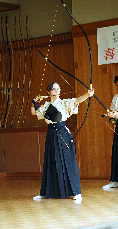 |
My name is Monica Howell. I do Japanese archery (kyudo) in Mobara-shi, Chiba-ken, Japan. I started at the end
of November, 2002. I received the rank of shodan on May 25, 2003.
I moved to Mobara in August of 2002. I had always wanted to do archery in the US, but never had a chance. Fromstudying about Japan in college, I'd heard of kyudo, and I hoped to have a chance to try it when I moved here. Ittook me a while, but I found out that classes were held at the city gym four times a week. I decided to go and take alook.
Because it was November when I went, it was already pretty cold. The kyudojo is half inside (where the archersstand to shoot) and half outside (where the arrows travel). The targets are in a sheltered area. The archers(kyudoka) wear short-sleeved white shirts (gi), belts (obi), skirt-like pants (hakama), and socks (tabi). The women alsowear chest protectors (muneate), and everyone wears a special glove (yugake) on their right hand while shooting.Although everyone had on long-sleeved shirts under their gi, they looked cold. Just sitting and watching, I wasfreezing.
There are a number of differences between Western archery and Japanese kyudo. The typicalJapanese bow (yumi) is 221cm (7ft. 4in.) long, and is usually made from bamboo. Arrows (ya)are made of metal or bamboo, and they have different tips depending on whether they're to beused with the regular targets or the practice target. The regular targets (mato) are 36cm(14in.) in diameter and are set at a distance of 28m (almost 92ft.) from the archer. Thepractice target (makiwara) is a tightly wrapped cylinder of straw and the archer stands about abow's length away from it to shoot.
number of differences between Western archery and Japanese kyudo. The typicalJapanese bow (yumi) is 221cm (7ft. 4in.) long, and is usually made from bamboo. Arrows (ya)are made of metal or bamboo, and they have different tips depending on whether they're to beused with the regular targets or the practice target. The regular targets (mato) are 36cm(14in.) in diameter and are set at a distance of 28m (almost 92ft.) from the archer. Thepractice target (makiwara) is a tightly wrapped cylinder of straw and the archer stands about abow's length away from it to shoot.
I spent about one and a half hours observing the kyudo practice. It wasn't a class as I hadexpected, but rather a practice observed by the teacher (sensei), who would make individual orgroup corrections as needed. All archers perform essentially the same actions in shooting,though obviously more advanced archers are more refined. One of the advantages of kyudo, tome, is that after learning the basic movements in shooting, you can begin to practice rightaway. Although it takes some time to get these steps down well enough to start (and to not bea danger to those around you), after that you are practicing with everyone else and doing thesame actions. It's therefore easy to observe the more advanced archers and attempt to refineyour own shooting.
I spent a couple of weeks practicing the shooting steps first without and later with a bow. My first try shooting thearrow at the makiwara I shot it into the wall instead, but after that I was okay. I shot solely at the makiwara for aweek or two, going to practice two times a week, and then moved to shooting at the mato. I think that traditionallybeginners are not allowed to shoot at the mato for a much longer period, but from talking to other beginners it seemsthat that is no longer the norm.
Kyudo, being a physical activity, can be learned with a minimum of Japanese language knowledge. Of course, themore you can speak, the better off you'll be, but if you can observe and imitate, you can get by with just a littleJapanese. Also, the sensei doesn't hesitate to make physical corrections. There are some books and websitesavailable in English that explain the history of kyudo and lay out in detail the shooting steps (hassetsu) andinformation on the materials needed. See www.kyudo.com. There is a written test as part of the ranking tests, but Iwas able to do mine in English.
I feel that there are a number of good points for doing kyudo. As I mentioned before, you can begin practicing fully ina relatively short time, though this will depend on your teacher, how many times a week you can practice, andwhether you study at home. However, it is not an activity that is easily mastered. Even kyudoka who have practicedfor decades do not hit the target every time. And of course, just hitting the target is not the point of kyudo. Thecomplexity of interaction between physical, mental, and spiritual activity in kyudo provides a challenge to even themost advanced kyudoka.
Kyudo is an individual activity, but is typically carried out in the presence of others. It is active enough to buildstrength and flexibilty, but is not high-impact and can therefore be practiced by people who cannot do activities likerunning or basketball. Because bows come in different sizes and strengths, people of almost all ages do kyudo - from12 or 13 year olds to people in their 80s (or more?). In addition, it is a good way for people (foreigners and Japanese)to learn about Japanese traditions and the Japanese way of working together and approaching things.
Kyudo has been beneficial for me in providing individual, strength-building exercise, while also enabling me to learnabout Japanese language and culture. It requires a lot of determination, but I really enjoy it.
Anyone with questions can email me at howe0096@yahoo.com.
